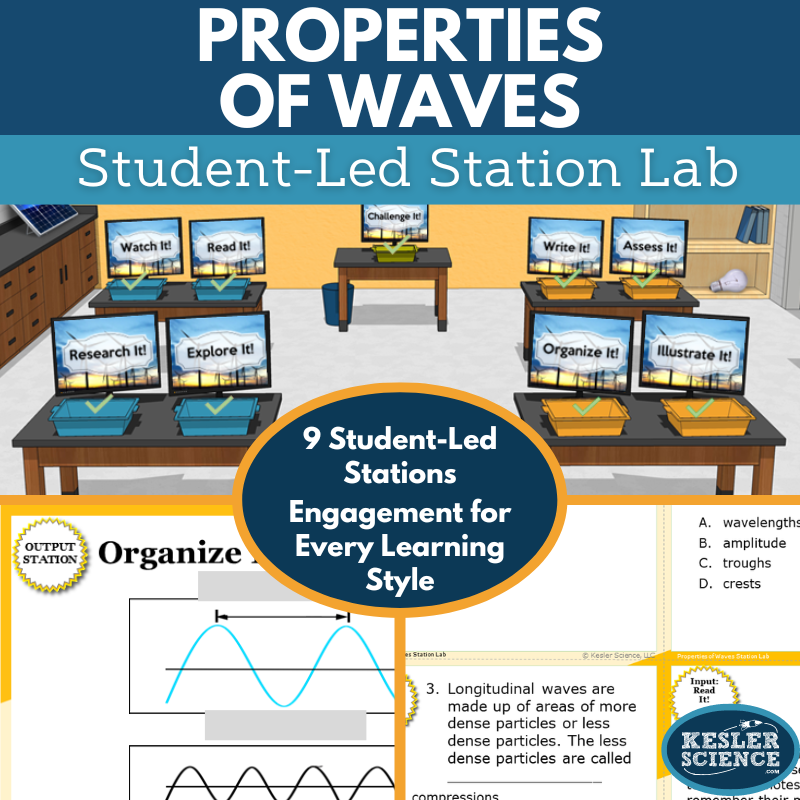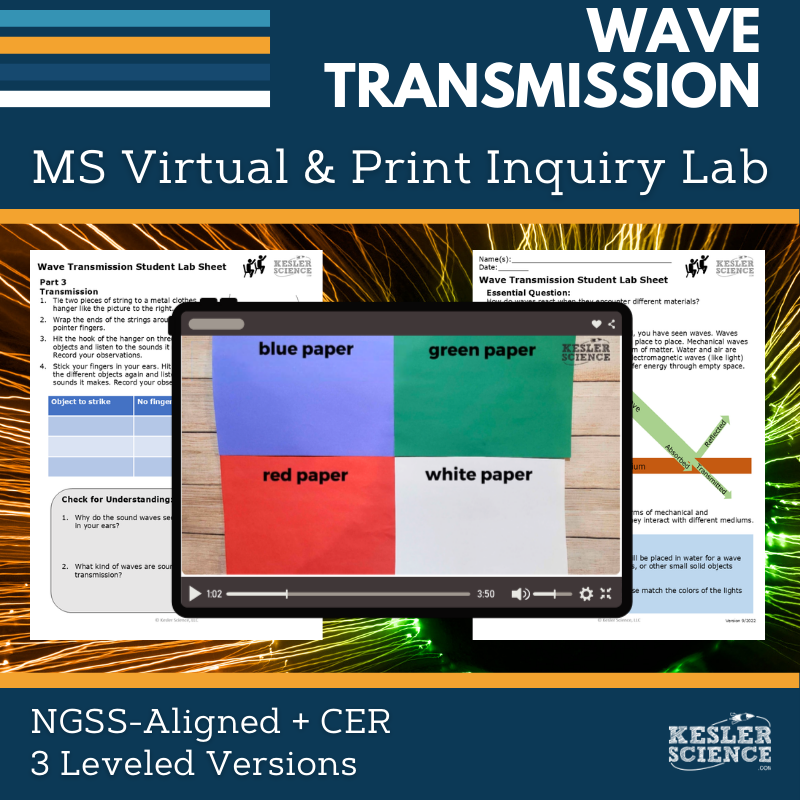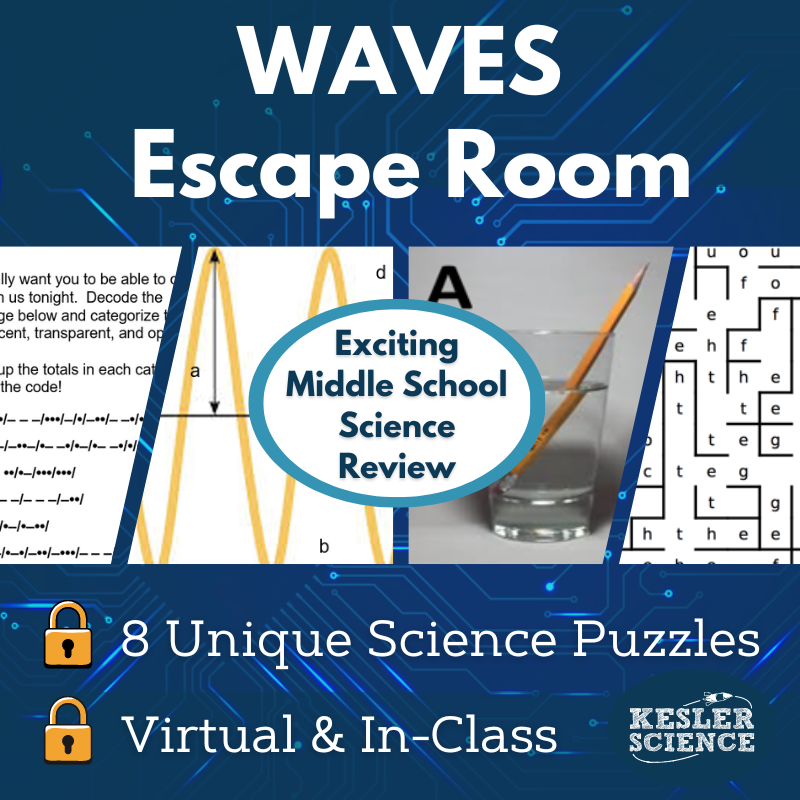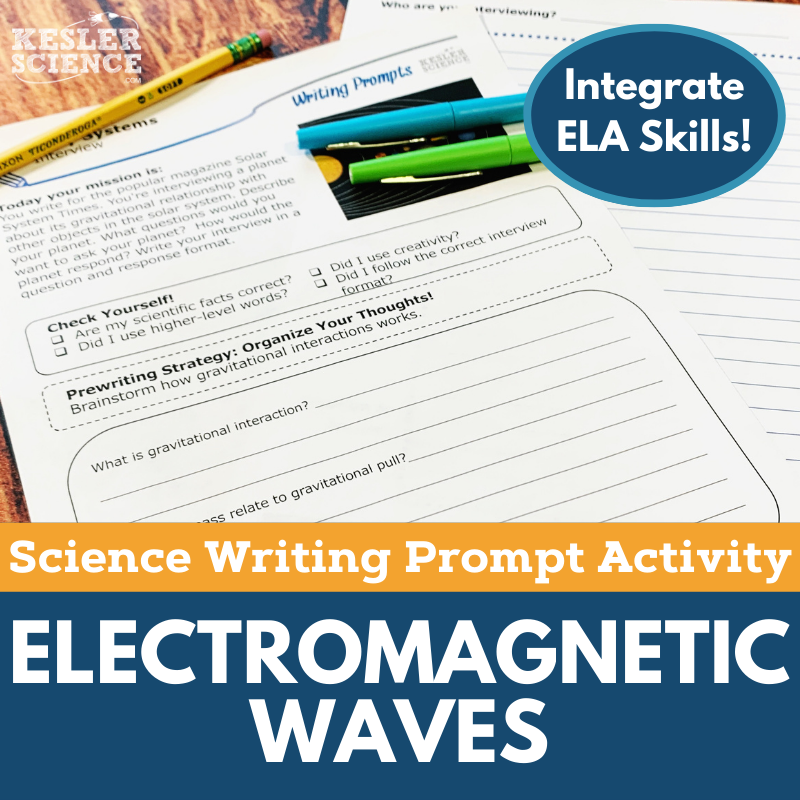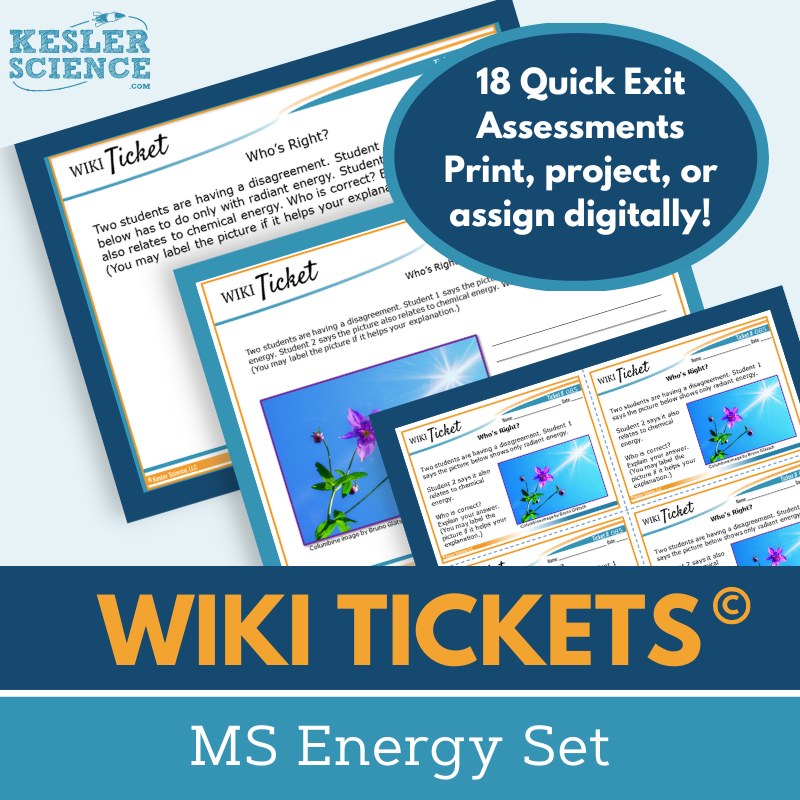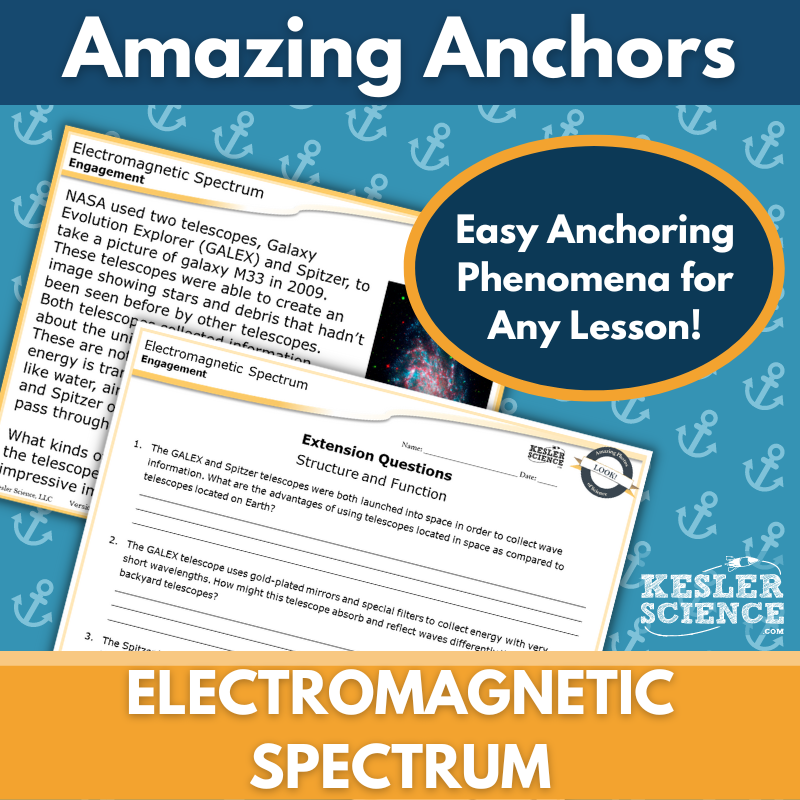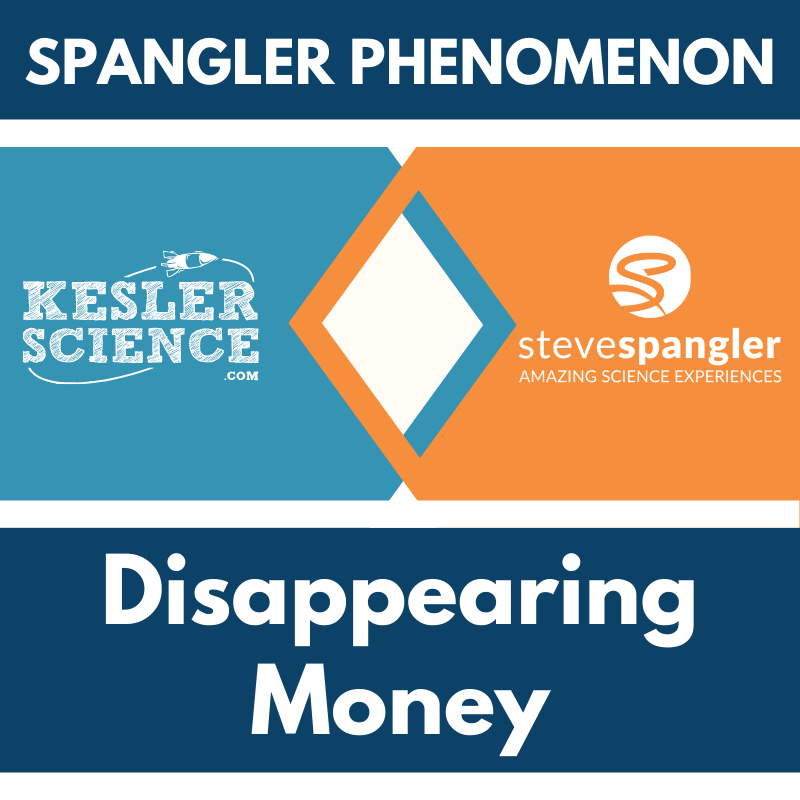Wave Transmission Activities for Middle School Science
Help your students grasp wave transmission with this engaging, student-led 5E lesson! The resources below will give students a comprehensive understanding of wave transmissions. All of the following materials are also included in the Kesler Science Membership.
The Kesler Science Properties of Waves 5E Lesson is a comprehensive, student-led unit designed for middle school classrooms. It includes editable presentations, worksheets, choice projects, and assessments aligned with TEKS and NGSS. This multiday lesson requires minimal prep and supports differentiated learning with multimodal resources, printable and digital formats, and Spanish translations of key materials.
Students explore essential questions about the interaction of matter and energy in waves, the three main types of mechanical waves, and wave properties. The 5E Model structure guides learning through engagement activities, a hands-on exploration station lab with nine differentiated stations, and interactive explanations using editable PowerPoints and notebooks. Elaboration activities allow students to extend their understanding through choice projects, while STAAR 2.0-aligned assessments ensure comprehension.
The lesson is highly flexible, supporting both in-class and virtual learning. Differentiated materials, multimodal instruction, and student-centered exploration make this resource engaging and effective for middle school science instruction.
The Kesler Science Properties of Waves 5E Lesson is a comprehensive, student-led unit designed for middle school classrooms. It includes editable presentations, worksheets, choice projects, and assessments aligned with TEKS and NGSS. This multiday lesson requires minimal prep and supports differentiated learning with multimodal resources, printable and digital formats, and Spanish translations of key materials.
Students explore essential questions about the interaction of matter and energy in waves, the three main types of mechanical waves, and wave properties. The 5E Model structure guides learning through engagement activities, a hands-on exploration station lab with nine differentiated stations, and interactive explanations using editable PowerPoints and notebooks. Elaboration activities allow students to extend their understanding through choice projects, while STAAR 2.0-aligned assessments ensure comprehension.
The lesson is highly flexible, supporting both in-class and virtual learning. Differentiated materials, multimodal instruction, and student-centered exploration make this resource engaging and effective for middle school science instruction.
Engage your middle school students with this student-led station lab on the properties of waves. This hands-on, interactive lesson allows students to develop and use models to describe how waves are reflected, absorbed, or transmitted through various materials while directing their own learning.
The station lab includes nine differentiated stations that provide multimodal ways to explore wave properties. Input stations introduce concepts through hands-on demonstrations, research, readings, and videos, while output stations help students demonstrate understanding through organizing information, illustrating models, writing responses, and completing assessments. A challenge station offers extension activities for early finishers.
Designed for both in-class and virtual learning, this low-prep resource includes all necessary signage, literature, task cards, and digital adaptations in PowerPoint and Google Slides. Differentiated reading passages in English and Spanish support diverse learners, making this an engaging and adaptable addition to your science curriculum.
Engage your middle school students with this student-led station lab on the properties of waves. This hands-on, interactive lesson allows students to develop and use models to describe how waves are reflected, absorbed, or transmitted through various materials while directing their own learning.
The station lab includes nine differentiated stations that provide multimodal ways to explore wave properties. Input stations introduce concepts through hands-on demonstrations, research, readings, and videos, while output stations help students demonstrate understanding through organizing information, illustrating models, writing responses, and completing assessments. A challenge station offers extension activities for early finishers.
Designed for both in-class and virtual learning, this low-prep resource includes all necessary signage, literature, task cards, and digital adaptations in PowerPoint and Google Slides. Differentiated reading passages in English and Spanish support diverse learners, making this an engaging and adaptable addition to your science curriculum.
The Properties of Waves Student Choice Projects lesson allows middle school students to select a project that matches their preferred output style. A project page outlines six different student-led options plus a “design your own” project, with an editable rubric for teacher, peer, or self-assessment.
These flexible, multimodal projects provide creative ways for students to demonstrate their understanding. Two versions of the project page support differentiation, with modified options for students needing remediation and challenge options for advanced learners. Teachers can adjust the rubric to fit grading needs.
The projects require standard classroom supplies such as paper, markers, and scissors, with many options available for digital completion.
The Properties of Waves Student Choice Projects lesson allows middle school students to select a project that matches their preferred output style. A project page outlines six different student-led options plus a “design your own” project, with an editable rubric for teacher, peer, or self-assessment.
These flexible, multimodal projects provide creative ways for students to demonstrate their understanding. Two versions of the project page support differentiation, with modified options for students needing remediation and challenge options for advanced learners. Teachers can adjust the rubric to fit grading needs.
The projects require standard classroom supplies such as paper, markers, and scissors, with many options available for digital completion.
The Wave Transmission Inquiry Lab aligns with NGSS MS-PS4-2, helping students develop and use models to describe how waves are reflected, absorbed, or transmitted through various materials. This lab offers both hands-on and virtual formats, providing flexibility for in-person and digital learning environments.
Students can engage with a pre-recorded video demonstration or conduct the experiment using printed materials. Both formats include comprehension questions, Claim-Evidence-Reasoning (C.E.R.) prompts, and reflection sections. The lab is available in three differentiated versions: dependent (guided inquiry), modified (structured with supports), and independent (student-led exploration).
In the hands-on version, students use materials such as metal pie pans, colored lights, and reflective objects to observe wave interactions. The digital format is an interactive PowerPoint compatible with Google Slides, featuring built-in activities and a recorded demonstration to simulate the experiment.
Editable resources allow teachers to customize materials, and teacher resource pages provide standards, objectives, prep time, directions, and answer keys. This lab ensures an engaging and adaptable learning experience for all students.
The Wave Transmission Inquiry Lab aligns with NGSS MS-PS4-2, helping students develop and use models to describe how waves are reflected, absorbed, or transmitted through various materials. This lab offers both hands-on and virtual formats, providing flexibility for in-person and digital learning environments.
Students can engage with a pre-recorded video demonstration or conduct the experiment using printed materials. Both formats include comprehension questions, Claim-Evidence-Reasoning (C.E.R.) prompts, and reflection sections. The lab is available in three differentiated versions: dependent (guided inquiry), modified (structured with supports), and independent (student-led exploration).
In the hands-on version, students use materials such as metal pie pans, colored lights, and reflective objects to observe wave interactions. The digital format is an interactive PowerPoint compatible with Google Slides, featuring built-in activities and a recorded demonstration to simulate the experiment.
Editable resources allow teachers to customize materials, and teacher resource pages provide standards, objectives, prep time, directions, and answer keys. This lab ensures an engaging and adaptable learning experience for all students.
The Waves Escape Room is an engaging activity that allows students to demonstrate their understanding of light and sound waves in a fun, interactive way. Students should be familiar with wave properties and vocabulary such as transparent, translucent, opaque, transverse, longitudinal, light waves, and sound waves before participating.
Unlike traditional escape rooms, teachers have full control over which of the eight independent puzzles to use and their sequence, making it adaptable for different class periods. The activity can be run using manila envelopes for a simple setup or with locks and a storage box for a more immersive experience. A digital version is available for online learning through PowerPoint or Google Slides, and a printable version can be assigned for at-home use.
This resource includes teacher directions, a detailed answer key, a digital answer sheet, an editable teacher version, and a video challenge to enhance engagement. Students will work through eight unique puzzles using all provided printable props, with reward templates, prize ideas, and photo-ready signs to celebrate their success. This standards-aligned escape room will keep students engaged and excited about learning wave properties.
The Waves Escape Room is an engaging activity that allows students to demonstrate their understanding of light and sound waves in a fun, interactive way. Students should be familiar with wave properties and vocabulary such as transparent, translucent, opaque, transverse, longitudinal, light waves, and sound waves before participating.
Unlike traditional escape rooms, teachers have full control over which of the eight independent puzzles to use and their sequence, making it adaptable for different class periods. The activity can be run using manila envelopes for a simple setup or with locks and a storage box for a more immersive experience. A digital version is available for online learning through PowerPoint or Google Slides, and a printable version can be assigned for at-home use.
This resource includes teacher directions, a detailed answer key, a digital answer sheet, an editable teacher version, and a video challenge to enhance engagement. Students will work through eight unique puzzles using all provided printable props, with reward templates, prize ideas, and photo-ready signs to celebrate their success. This standards-aligned escape room will keep students engaged and excited about learning wave properties.
This Science Reading Comprehension Lesson explores electromagnetic waves through a nonfiction article about WiFi signals. Designed for middle school, the leveled passage enhances science literacy and reading comprehension.
The resource includes two leveled articles (Lexile 1100-1300), five to seven comprehension questions, a hands-on mini-project, and a Cornell notes template. The passage is suitable for grades 6-8 and higher-level 5th graders.
Ideal for sub plans, ISS, extra credit, or whole-class instruction, this resource fosters critical thinking, classroom discussions, and textual analysis. It is compatible with virtual learning platforms like Google Classroom, MS Teams, Schoology, and Canvas, allowing students to respond directly within digital documents.
This Science Reading Comprehension Lesson explores electromagnetic waves through a nonfiction article about WiFi signals. Designed for middle school, the leveled passage enhances science literacy and reading comprehension.
The resource includes two leveled articles (Lexile 1100-1300), five to seven comprehension questions, a hands-on mini-project, and a Cornell notes template. The passage is suitable for grades 6-8 and higher-level 5th graders.
Ideal for sub plans, ISS, extra credit, or whole-class instruction, this resource fosters critical thinking, classroom discussions, and textual analysis. It is compatible with virtual learning platforms like Google Classroom, MS Teams, Schoology, and Canvas, allowing students to respond directly within digital documents.
The Electromagnetic Waves Science Writing Prompt Activity engages middle school students in a creative letter-writing exercise to reinforce their understanding of how waves are reflected, absorbed, or transmitted through various materials. Aligned with NGSS MS-PS4-2, this low-prep, student-centered activity supports science reasoning and exploration while allowing for both in-person and virtual learning.
This resource includes teacher directions with an answer guide, project ideas, and rubrics; projection and print handouts in full-sized and half-sheet formats; and a digital interactive version in PowerPoint, compatible with Google Slides. The activity works well as a cross-curricular exercise, pre-test assessment, student choice project, or enrichment for early finishers. It is also useful for extra credit, make-up work, TELPAS samples, or differentiation.
Ideal for engaging students in meaningful science writing, this prompt can be displayed on a bulletin board or compiled into an anthology. Because it is designed for review, students should have prior knowledge of the topic or access to research materials.
The Electromagnetic Waves Science Writing Prompt Activity engages middle school students in a creative letter-writing exercise to reinforce their understanding of how waves are reflected, absorbed, or transmitted through various materials. Aligned with NGSS MS-PS4-2, this low-prep, student-centered activity supports science reasoning and exploration while allowing for both in-person and virtual learning.
This resource includes teacher directions with an answer guide, project ideas, and rubrics; projection and print handouts in full-sized and half-sheet formats; and a digital interactive version in PowerPoint, compatible with Google Slides. The activity works well as a cross-curricular exercise, pre-test assessment, student choice project, or enrichment for early finishers. It is also useful for extra credit, make-up work, TELPAS samples, or differentiation.
Ideal for engaging students in meaningful science writing, this prompt can be displayed on a bulletin board or compiled into an anthology. Because it is designed for review, students should have prior knowledge of the topic or access to research materials.
The WIKI Tickets© Energy Set provides engaging formative assessments for 6th-8th grade science, offering flexible ways to check student understanding. This set includes 18 topics, each available in five formats: a full-screen projection version, three printable handouts (full, split, and quarter-page sizes), and an interactive digital version compatible with PowerPoint and Google Slides.
Aligned to NGSS and TEKS standards, these assessments ensure comprehensive coverage, with at least one ticket per standard. A bonus table of contents file is included for alignment reference. Designed for both in-person and virtual learning, WIKI Tickets© can be used as exit tickets, bellringers, or quick checks. Topics covered include energy transformations, heat transfer, wave characteristics, wave models, and more. Students can respond on printed handouts, their own paper, or digitally in a 1:1 or remote setting. These vibrant, ready-to-use assessments help you gauge student progress effectively in any learning environment.
The WIKI Tickets© Energy Set provides engaging formative assessments for 6th-8th grade science, offering flexible ways to check student understanding. This set includes 18 topics, each available in five formats: a full-screen projection version, three printable handouts (full, split, and quarter-page sizes), and an interactive digital version compatible with PowerPoint and Google Slides.
Aligned to NGSS and TEKS standards, these assessments ensure comprehensive coverage, with at least one ticket per standard. A bonus table of contents file is included for alignment reference. Designed for both in-person and virtual learning, WIKI Tickets© can be used as exit tickets, bellringers, or quick checks. Topics covered include energy transformations, heat transfer, wave characteristics, wave models, and more. Students can respond on printed handouts, their own paper, or digitally in a 1:1 or remote setting. These vibrant, ready-to-use assessments help you gauge student progress effectively in any learning environment.
Lesson Extensions provide engaging, student-choice activities designed to challenge early finishers and deepen their understanding of energy concepts. These activities encourage critical thinking, creativity, and problem-solving while preventing distractions and making use of downtime. Aligned to NGSS and TEKS energy standards, they support independent learning and enrichment.
Each extension includes four interactive components: Puzzler for problem-solving, Maker Space for hands-on STEAM activities, Tech Connection for digital demonstrations, and Word Master for creative writing. With teacher directions, answer keys, and both print and projection versions, these extensions offer flexible, rigorous learning opportunities.
Covering topics such as energy transformations, kinetic and potential energy, thermal energy transfer, the electromagnetic spectrum, and photosynthesis, these extensions help students explore energy concepts in a meaningful way. Perfect for lesson wrap-ups, early finishers, or independent challenges, Lesson Extensions ensure continued engagement and deeper learning.
Lesson Extensions provide engaging, student-choice activities designed to challenge early finishers and deepen their understanding of energy concepts. These activities encourage critical thinking, creativity, and problem-solving while preventing distractions and making use of downtime. Aligned to NGSS and TEKS energy standards, they support independent learning and enrichment.
Each extension includes four interactive components: Puzzler for problem-solving, Maker Space for hands-on STEAM activities, Tech Connection for digital demonstrations, and Word Master for creative writing. With teacher directions, answer keys, and both print and projection versions, these extensions offer flexible, rigorous learning opportunities.
Covering topics such as energy transformations, kinetic and potential energy, thermal energy transfer, the electromagnetic spectrum, and photosynthesis, these extensions help students explore energy concepts in a meaningful way. Perfect for lesson wrap-ups, early finishers, or independent challenges, Lesson Extensions ensure continued engagement and deeper learning.
This NGSS-aligned Amazing Anchors Phenomenon Lesson introduces and reinforces the electromagnetic spectrum through real-world connections. It includes an introductory reading on telescopes with comprehension and extension questions to prepare students for further learning, followed by an explanatory reading that breaks down the science behind the electromagnetic spectrum and reading telescopes in an accessible way. Additional comprehension and reinforcement questions extend student understanding.
This no-prep resource includes teacher directions, answer keys, projection slides, and both print and digital formats for Google Classroom and other LMS platforms. A differentiated version provides sentence starters for student support. Designed to bookend a lesson, these engaging readings serve as supplements to reinforce learning in any in-person or virtual classroom.
This NGSS-aligned Amazing Anchors Phenomenon Lesson introduces and reinforces the electromagnetic spectrum through real-world connections. It includes an introductory reading on telescopes with comprehension and extension questions to prepare students for further learning, followed by an explanatory reading that breaks down the science behind the electromagnetic spectrum and reading telescopes in an accessible way. Additional comprehension and reinforcement questions extend student understanding.
This no-prep resource includes teacher directions, answer keys, projection slides, and both print and digital formats for Google Classroom and other LMS platforms. A differentiated version provides sentence starters for student support. Designed to bookend a lesson, these engaging readings serve as supplements to reinforce learning in any in-person or virtual classroom.
This Spangler Phenomenon lesson on reflection, absorption, and transmission of waves features an exclusive Steve Spangler video designed for Kesler Science. The interactive investigation engages students with the Really Big Question: How does the structure of certain materials affect the way light and sound waves interact with them?
Aligned with middle school NGSS physical science and built on the 5E framework, this lesson encourages students to think, study, and work like scientists. In Part 1, students explore the phenomenon by watching the "Disappearing Money" video and creating their own shoebox projector. In Part 2, they gather information from an engaging article on wave interactions, with opportunities to expand learning through station and inquiry labs. In Part 3, students refine their conclusions after watching an exclusive explanation video and demonstrate their understanding through writing, drawing, or building activities.
Each lesson includes detailed teacher directions, student handouts, two Steve Spangler videos, clear presentation slides in standard and interactive formats, and PowerPoints that integrate smoothly with Google Slides. Vimeo links ensure an ad-free viewing experience.
This lesson provides an exciting opportunity for students to explore how materials influence the behavior of light and sound waves in an engaging, hands-on way.
This Spangler Phenomenon lesson on reflection, absorption, and transmission of waves features an exclusive Steve Spangler video designed for Kesler Science. The interactive investigation engages students with the Really Big Question: How does the structure of certain materials affect the way light and sound waves interact with them?
Aligned with middle school NGSS physical science and built on the 5E framework, this lesson encourages students to think, study, and work like scientists. In Part 1, students explore the phenomenon by watching the "Disappearing Money" video and creating their own shoebox projector. In Part 2, they gather information from an engaging article on wave interactions, with opportunities to expand learning through station and inquiry labs. In Part 3, students refine their conclusions after watching an exclusive explanation video and demonstrate their understanding through writing, drawing, or building activities.
Each lesson includes detailed teacher directions, student handouts, two Steve Spangler videos, clear presentation slides in standard and interactive formats, and PowerPoints that integrate smoothly with Google Slides. Vimeo links ensure an ad-free viewing experience.
This lesson provides an exciting opportunity for students to explore how materials influence the behavior of light and sound waves in an engaging, hands-on way.
Year-Round Resources
These year-round activities will increase your students' understanding of many middle school science topics. All of these activities are also included in the Kesler Science Membership.
Visual Data & Graphing
You're not alone if your students struggle with understanding graphs, charts, and tables. It's a skill that takes an enormous amount of practice. This resource will help students build a strong foundation in analyzing data and creating their own data visualizations.
Bell Ringers and Warm-Ups
These middle school science bell ringers are an excellent way to engage your students as soon as they walk into your classroom. This comprehensive FULL YEAR resource includes everything you need to start off each science class with an interesting warm-up activity.
Review Board Games
Each game board has been carefully designed to keep students engaged. There are 10 different action spaces on each board and dozens of question cards. All of the actions are related to science concepts and keep the students motivated throughout the game.
Each game is ready to play. Simply print out the board and the cards and let the students enjoy reviewing nine different units.
Essential Questions and Standards
Below are the essential questions and standards associated with the lessons and activities included in the wave transmission unit. This topic is only one of more than 100 middle school science topics included in the Kesler Science Membership.
-
How do matter and energy interact when waves are generated?
-
What are the three main types of mechanical waves?
-
What are properties of waves?
-
How do waves react when they encounter different materials?
-
NGSS - MS-PS2-4 Wave Transmission
Kesler Science Membership
Imagine never having to search for another middle school science lesson again. The membership gives you access to ALL of the Kesler Science products in one place (Yes, including everything above).
Say goodbye to long hours of lesson prep.



